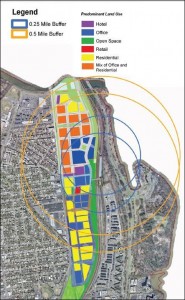by James A. Bacon
The state will help finance a new Metro station in Alexandria through a $50 million loan from the Virginia Transportation Infrastructure Bank approved by the Commonwealth Transportation Board earlier this week. The loan is a key piece of financing for the station, which is expected to cost between $209 million and $268 million to build. In turn, the Metro station is a key piece of infrastructure to advance development of between 9.2 million and 13.1 million square feet of residential, office, retail and hotel space in the Potomac Yard.
While the Metro project doesn’t pass the Bacon litmus test for 100% user-pays financing, it does better than most mass transit projects Virginia has underwritten, and it would open up 300 acres for high-density, high-value development only five miles from the core of Washington, D.C.
The Potomac Yard, to be built on an old CSX railroad marshaling yard south of Ronald Reagan National Airport, could be Northern Virginia’s most important urban infill project of the early 21st century. Plans call for the creation of between 4,300 and 7,100 residential units, 3.2 million and 4.2 million square feet of office space, nearly 800,000 square feet of retail and 740 hotel rooms. We’re not talking about development that might happen… some day. There is a strong, demonstrated demand for the kind of walkable urbanism planned at Potomac Yard.
From what I can tell from perusing public documents, the City of Alexandria is approaching this project the right way. The land use plan calls for creating a balanced mix of uses in a walkable environment with the goal of maximizing transportation infrastructure by distributing peak traffic over longer periods, maximizing internal trips and maximizing transit use. The plan also would put most parking underground, reducing the need for parking spaces by creating opportunities for shared parking, such as office buildings using parking during the day and residences during the night. Highest density development will be located around the Metro station.
I will say this: $200 million+ strikes me as an extraordinary amount of money to build a single Metro station. There are complicated trade-offs to be made with the station siting. A final decision and cost have yet to be determined. The problem is that the station must work within narrow confines around the existing rail line. Depending upon the design alternative selected, that entails building pedestrian bridges, retaining walls and/or new Metrorail bridges. The complexity of the construction staging is rated moderate to high, and considerable construction would take place along live tracks.
Complexity comes with the territory in in-fill projects. The key question is whether the project creates sufficient value to justify the higher cost. And there’s really only one way to tell: Are developers willing to absorb the cost of constructing the Metro station, or would doing so price their office, residential and retail space out of the market?
We’ll never know the answer because Alexandria isn’t loading the full cost of the Metro station construction upon the developers who stand to benefit through higher rents and leases on their properties. According to the Potomac Yard Metrorail Station Environmental Impact Statement, the project cost including interest will total $496.6 million. In 2010, the original idea was for developers to contribute $74 million directly, another $194 million through revenues generated through a special tax district, and the rest through regular taxes paid, which Alexandria would use to support municipal debt. But financing plans have evolved since then. Now the City of Alexandria is seeking $67 million from the Northern Virginia Transportation Authority. And the loan from the Virginia Transportation Infrastructure Bank (VTIB) lock in an interest rate of 2.17 percent over 30 years, reducing much of the interest expense.
In a presentation to the CTB, Assistant Transportation Secretary Nick Donohue described the VTIB loan’s complex debt structure. Repayment is secured by a combination of revenue from the special tax district and moral obligation of the City of Alexandria. Not all details have been finalized. “Upon CTB approval,” states the presentation, “additional specific loan terms will be determined as project, schedule and related documents are finalized.”
Bacon’s bottom line: There are still big unknowns to this project. We don’t know how much the Metro Station will cost. A final design hasn’t been selected, and almost every mass transit project known to man seems to undergo mission creep and cost escalation. Further, we don’t know the final terms of the VTIB loan. With those important caveats, it appears that this project comes closer to to paying its own way than any Virginia mass transit project I can recall.
There are no federal dollars. There likely will be state dollars, but they will come from the Northern Virginia Transportation Authority, which means that down-state taxpayers will not be subsidizing the project. The commitment of VTIB funds represents a small interest rate subsidy and there is a small risk that the money may not be paid, so in theory state taxpayers could be on the hook for some portion if things turn sour.
But this project differs from every other Virginia mass transit project in that developers will contribute a $74 million (2010 estimate) through direct contributions, $194 million (2010 estimate) through special tax district contributions, and millions of dollars more through payment of regular taxes used to service City of Alexandria municipal bonds. That’s a far greater contribution than will come, say, from developers/property owners of the Silver line or property owners along the Norfolk light rail line.
This is a preliminary analysis based upon a cursory examination of public documents. I invite closer scrutiny by others. But my impression is that, when it comes to paying for mass transit, this is probably the best deal that Virginia taxpayers have ever seen. The Alexandria Metro station should serve as a mass transit-financing model for the rest of the state.



